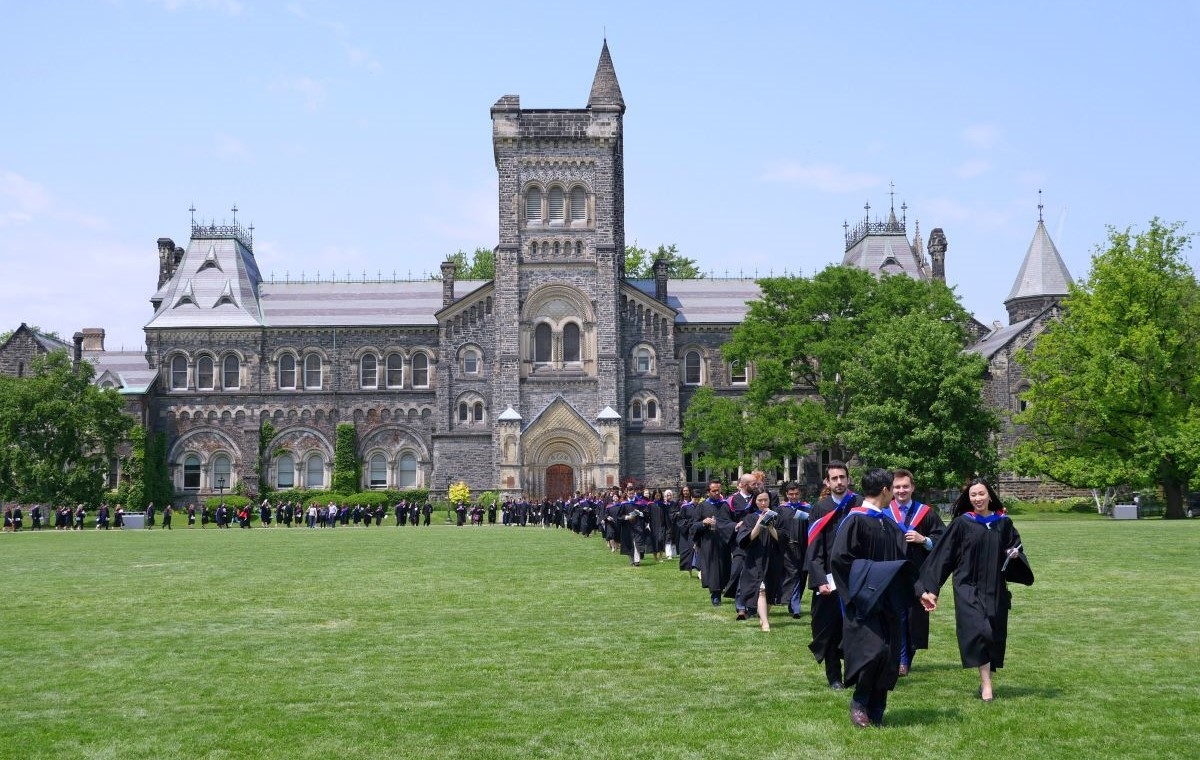
The long decline of university undergraduate education: causes and remedies
The generation-long decline of most North American universities has been so gradual that informed observers possessed of only a modicum of denial might have been able to believe either that they are witnessing a small cultural shift or, perhaps, the minor setbacks that are the reasonable price of the laudable goal of bringing the benefits of higher education to as many as possible.
They should be excused our opprobrium, because the decline cannot be attributed to a single, obvious cause. It is due to a constellation of forces which are not obviously related either to higher education or to each other, and which evoke quirky unintended consequences.
The most obvious of these unintended consequences is that, except for professional degree programs which must meet standards set by the regulatory bodies of those professions, most programs of undergraduate study have been considerably “dumbed down” in recent years. On top of this, most universities have needed to institute remedial writing programs and workshops for new undergraduates.
There are, of course, other aspects of the decline as well, including issues surrounding academic freedom and free inquiry, overly specific targeting of research funding, and confusion over the purposes of university education, but I have previously written about all of these in this magazine, and those articles are still available on this site (Ottawa Life Magazine, Aug 10, 2020, Aug 31, 2020 and Oct 12, 2020).
Why has it been necessary to dumb down the starting point of most undergraduate programs?
Universities do not exist in isolation, so changes in the broader society must, of necessity, impinge upon them. One profound change is that the students entering university are less well prepared for exposure to higher education than they were in the past.
This is due in part to the ideologies which now hold sway with respect to primary and secondary education in North America. A wag might joke that primary and secondary school students are now expected to get their socialization at school and their education at home. This is almost true. There is a huge emphasis in our schools on not harming the delicate psyches of students, so all are advanced and rewarded regardless of the true level of accomplishment. Few or none are held back to repeat a year. The more accomplished recognise that rewards for true excellence are minimal, and that they can get by with less effort. Many are often pleased to coast, or become bored and inattentive.
Furthermore, the current popular tool to combat boredom is the notion that to be interesting all education must be active learning, ie discovery by problem-solving. While there is no doubt that problem-solving and active learning have real uses, the technique has become so pervasive and all-enveloping that almost all of the knowledge that students acquire is expected to come via this route. Almost none is just learned in the traditional fashion, ie from books or by hearing lectures and taking notes. The problem with this is that it took humans a few thousand years to discover all of our current knowledge via the active learning or problem-solving route. Even in well stage-managed situations, our students will never live long enough to get a good bit of it all by experimentation and problem-solving. Hence the coverage must, perforce, be rather thin.
But the slowdown in acquiring knowledge due to using these “modern” learning techniques and the demotivation of good students by an undifferentiating reward system are only part of the story. It is compounded by the profound societal shift from emphasis on collective rights to emphasis on individual rights and a culture of grievance. Teachers in primary and secondary schools now wield very little authority, to the point where they are physically imperilled and deprived of most tools for keeping order in their classes and fostering the flow of work. Some of the changes that brought this situation about were needed, and no-one is advocating a return to an era when a teacher could be cruel or violent with impunity, but as with all swings of the pendulum, it may have gone rather too far before beginning to return to a logical middle ground.
All this to say that a non-trivial fraction of students leaving high school and expecting to attend a university cannot write a coherent paragraph, make a logical argument, carry out basic mathematical tasks, or analyze data, and are woefully unaware of the underpinnings of world culture.
Universities recognize that many bright and capable entrants have been let down by these preparatory systems, and have tried to remediate these lacunae with special classes which are, in effect, an accelerated version of what should have been done for those students during the decade before. But the quick fix is never going to be as good as doing it better in the first instance.
The universities, however, can not blame all the dumbing down of undergraduate programs on the systems of pre-university educational preparation. The universities themselves are partly responsible. Yes, the starting point of an undergraduate program may now be lower, but that’s not the whole story. From that point forward, the material coverage is thinner than it once was, and the slope is flatter.
Why has there been a decline in the quantity of material to which undergraduates are exposed?
Surprisingly, a major reason for the flattened up-slope of most university undergraduate programs is economic. Tuition fees have generally risen faster than inflation and typical student debt levels are remarkably high. Hence, most students need to earn some money while they are at university. It would be fair to say that at one time, for students in an undergraduate programme, study was their full-time job, at least for the two thirds of the year when regular undergraduate programmes were in session. Now, however, the need of so many to hold part-time jobs during the Fall and Winter while studying has made full-time university attendance into something less than the student’s full-time job. Universities, seeing looming non-completion rates, have done the only thing they could do in response: they flattened the slope, which is to say they reduced the amounts of materials to be read, of essays to be written, and of hours of study needed to keep abreast of any given course, because to fail to do so would be just to leave behind a cohort of folk who needed to engage in gainful employment during the Fall and Winter terms.
But the economic driver is not the only one responsible for the flatter slope of most undergraduate programs. Another is simply that many university students shouldn’t be there, will benefit little from their time there, and could have been happier and more fulfilled doing something else. In adapting to that group, the universities slow down learning for the serious ones.
This is a controversial statement, and easily misinterpreted, so I state a priori that there are still substantial numbers of capable North American young (and not so young) people who would benefit greatly from a university education, but who, for a variety of reasons, cannot attend, and there is no doubt that there continue to be issues of socioeconomic stratification related to tertiary education that remain to be resolved.
But on the other hand, there are vast numbers of students at university who ought not to be there and are wasting our time and theirs, and a fair bit of their parent’s money. There are three big cultural reasons for this.
Why are there so many university students who should be doing something else?
The first reason is that, for many young people, the rite of passage of going away to university, of being away from parental supervision during that critical period of young adulthood, and of partying for four years in an environment of great freedom is a life objective in and of itself, with the educational aspect being entirely secondary. During the recent admissions scandals in the US, some of the children of prominent folk who were exposed as having gained admission by dubious means were very candid about their purely social reasons for wanting to go to those universities. Frankly, there is far too much going away to school, partly fostered by the notion that there are great universities, usually at some distance, that one must try to get in to.
The fact is, at the undergraduate level, one can get a perfectly good education at most universities. A case can be made, indeed, that there are actually no great universities. Universities are built one programme at a time, and there are many great university programmes. The universities we have come to think of as great may well have a higher ratio of great programmes than the others. But be assured that almost all universities have some great undergraduate programs, and even the so-called “great” universities have a few utterly weak undergraduate programmes. The majority of serious students who live in urban centres could save vast resources by doing a good undergraduate degree while living at home, using the resultant decrease in economic pressure to treat the study as the full-time occupation, and then using the good result thereof to get into a good graduate programme.
The second reason is that, as a society, we have somewhat lost the idea of the dignity of labour, which was a key touchstone of the old left. What is “respectable” now is to go to university after high school. Lesser tertiary education institutions are often viewed as the place for those who couldn’t qualify for university. Trades, even brainy ones, are viewed as second best, despite all the data that they may provide better incomes and may make a more substantial contribution to the society as a whole. Frankly, I would rate a good cabinetmaker, machinist, technologist or chef over a bad sociologist any day of the week. We have become too snobbish to respect and honour honest skilled work.
The third reason for the presence in universities of a certain number of undergraduates who will benefit little, and are just being “stored” there is essentially political, especially in Canada, where there are virtually no private universities, and all universities are heavily supported by the upper two levels of government. The political reason is that they keep a lot of the children of the influential middle and upper middle classes off the unemployment rolls, and thereby make the governments look good in terms of their economic policies. Thus most government funding for universities uses a funding formula based on numbers of students, with some variation in the values of individual programs. The universities, therefore, can only make ends meet by continuing to grow enrollment, which suits the political aims of their paymasters exquisitely, but does not do much for their standards, their class sizes, or the ideals of a university.
How has this eroded the university ideal?
Universities “store” most of these less well-suited students by creating cafeteria-style programs without a coherent core, where the majority of courses are a jumble of unrelated electives, and persist in calling such education a “liberal education”. A real liberal education is hugely valuable, and specialization, if desired, need not occur early, but an unplanned four-year incoherent salad of introductory courses is unhelpful. This greatly misrepresents what a liberal education can and should be (see Education, Information and Democracy, Ottawa Life Magazine).
The universities then try to steer the more capable students into more goal-directed programs. Such programs, including professional ones, often have maintained a better standard because of the pressures of accreditation by outside professional bodies, but that leaves the universities with a huge dilemma. Their flagship programs have become the ones which are targeted towards preparation for specialized jobs. They have staked their reputations on becoming high-class trade schools.
Can aspects of the decline be halted, and perhaps reversed?
There is no single magic bullet that will address this farrago of challenges that our universities face. And where the root causes lie outside the universities, the ameliorations they can achieve by their own action are, of necessity, partial. But there are first steps that could blunt the decline and set the stage for further progress.
To their credit, in most universities, the teaching techniques used are better, on average, than they were a generation or two ago. This is due to two factors. The first is the prevalence of teaching assessments by students and by peers, and the use of these assessments in promotion and tenure processes. The second is that today most institutions actually try to give some modest instruction to their graduate students, teaching assistants and part-time teachers on effective teaching methods. In times past, this was often not the case. The older approach was that a person studied and researched until they got an advanced degree, and then, either as graduate students or as young faculty, were assumed to be able to teach by simply emulating their own profs. They were then paid to commit pedagogy on an unsuspecting public without actually preparing them to do so. Thankfully, that era is largely passed. Even the hiring process for new faculty usually involves giving some sort of demonstration of one’s lecturing skills.
And for many of the problems and failures discussed above, the remedies are implicit in the descriptions of the pathologies. There are, however, some as yet unmentioned steps which could be taken to address the twin issues of high cost and decline in level and content of undergraduate programs. I use the term “twin” since, as we have already seen, the high cost and the resulting need for many to earn substantially while studying has been one factor in the thinning out of the degree content.
Before the Covid-19 pandemic, the cost of most undergraduate programs was partly driven by the reliance by the majority of universities on an unrelieved pre-Gutenberg model of instruction. By that I mean seating students in front of a lecturer to take notes as if the printing press had not yet been invented. Yes, I do understand that the professor may indeed refer to texts and there may be an official course text and prescribed readings, but physically sitting in the classroom has remained the expected norm for undergraduate students. And I do recognize that it is part of the social experience and is an aspect of the cultural going-away-to-university entitlement.
But over the past 20 years, the improvement in the delivery of on-line and distance-delivery courses is stunning. The residential universities at first sneered at these developments and then grudgingly adopted them for their part-time students (which they largely viewed as second-class students). That was already starting to change when the Covid-19 pandemic forced a huge shift to on-line learning. And while there have been teething problems, what is striking is how quickly the institutions have adapted when driven by absolute necessity.
For undergraduate programs which are not highly specialized or in regulated professions, one can easily imagine a future in which a significant fraction of students could get a first rate education by attending their local university for those courses that the local one, however small, does well, and filling in the gaps with on-line offerings from wherever they are excellent, transferring all credits to one of the institutions they are using and getting their degree with good courses, logically selected, at a fair price, while living at home.
Universities could also improve the degree quality by moving a bit away from the somewhat overdone cafeteria-style approach to the jumble of courses leading to some of their less specialized degrees, and shift a bit more towards core curricula, while still allowing for some electives. No one is suggesting the rigidity of the content of a given degree that was typical of the offerings in the 1960’s, but the pendulum has swung so far the other way that many degrees look like a flock of introductory courses flying in loose formation, with very few advanced courses enabled by having as prerequisites the successful competition of related introductory and intermediate courses.
Another experiment which might well make university accessible to some who are now excluded would be an alternate path to admission via examination rather than past secondary school or college record. There are hints of this in the way many universities admit mature students, but more is possible.
There is another use of examinations that could dramatically reduce costs for a subset of relatively capable students. Imagine a course for which a detailed course outline and plan is published. Many courses already have this. For those inclined to study and learn independently, a less expensive alternative to taking the whole course might be for the institution to offer a challenge exam for that course which a person could pay to take, and if they succeeded, would then pay a further fee to have the credit for the course recorded. The exam fee and the course credit fee together would be much less than the cost for the whole course, but still enough to appropriately compensate the university, while having the additional benefit of taking some pressure off of class sizes.
None of these small adjustments will make university education cheap, just less expensive. Student loan systems supported by government remain essential, but they have a particular weakness, which is that the looming debt scares off many, particularly from poorer families, and has profound and often unhelpful steering effects both on program choices and on later occupational choices. It is a system which, perhaps unintentionally, drives people away from socially and culturally important disciplines which do not necessarily lead to high compensation. Not all of this steering is bad, because high compensation in an occupation often implies a high demand for and a shortage of such folk in the broader society. But the steering has become all-pervasive, and it risks relegating into obscurity some subjects that society as a whole would be loath to lose. The least disruptive curative for this is an income-contingent student loan repayment scheme. This approach has been tried in some countries, and has merit. Under such a scheme, all student debt would be repaid, but students whose future earnings turn out to be modest will end up paying somewhat less than they borrowed, while students whose subsequent earnings are more substantial will end up paying back somewhat more than they borrowed. Such schemes are rather like the concept of progressive tax rates on income, a widely accepted notion. The amount of the shift of debt from the poorly paid to the better paid is a matter of tuning the income-contingent repayment scheme, but should not be so great as to give anyone a nearly free ride.
Our undergraduate programs could and should be better. And while the repair may take almost as long as the decline, it will likely be more fun.
Photo: iStock, peterspiro







